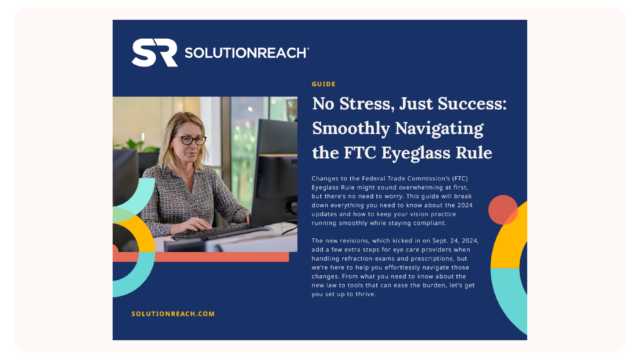Think it’s not that big of a deal when a patient doesn’t show up for a scheduled doctor’s appointment? Over time, missed medical appointments in the U.S. add up to the tune of more than $150 billion a year! On average, that costs your practice about $200 per unused appointment slot.
Just as important as lost revenue, missed appointments can have a direct impact on a patient’s health, as well. When patients miss appointments – preventive care and follow-up treatments included – there’s a lack of continuity in their care. If this becomes a habit, acute problems, like cavities or a change in vision, are more likely to become bigger conditions, like root canals and undetected eye diseases.
9 strategies to reduce patient no-shows and boost revenue
We’ve put together a list of nine things you can start doing to recall patients, achieve a higher level of income, provide optimal patient care, and dramatically lower your no-show rate. Even if you start with a couple of them, you’ll see a difference!
1. Identify patients for recall.
Use an automated patient recall system to identify patients who are overdue for preventive care, have unfinished treatments, or have missed appointments. Then, target this list with increased communication via phone calls, text message, email, newsletters, and social media.
2. Send text messages as automated appointment reminders.
Once you’ve identified patients who need to get back into the office, reach out via text to let them know or to remind them of an upcoming appointment. Texts reduce no-shows by 30%–50% and help patients remember when they’re past due for treatment.
3. Send emails.
Automate recall emails to specific groups of patients, such as those who’ve missed appointments, those who are overdue, and those who need follow-up care. Stagger the emails with texts you send so you don’t get overwhelmed with too many patients trying to get on the schedule! (It can happen!)
4. Follow up with a short survey.
One of the best things you can do to reduce no-show appointments is to determine why they aren’t showing up in the first place. A short survey (sent via email or text) can help uncover reasons you haven’t seen them for regularly scheduled cleanings, preventive care, and exams. Once you know why they’re not coming in, you can take action to correct any issues or concerns.
5. Offer a variety of financing options.
Money is a common reason that patients skip out on healthcare. In fact, one in three Americans puts off treatment because they can’t afford it and their providers don’t offer financing options. Give your patients payment options, like Care Credit and in-office payment plans, as incentives to come back for necessary care.
6. Educate your patients with newsletters.
Patients love reading newsletters. In fact, 85% of them say they enjoy receiving them from their healthcare providers. Regular patient education newsletters fosters patient communication and is a great recall strategy.
7. Reach out on social media.
Your patients (and potential new patients!) are on social media every single day. Why not use this platform to your advantage to connect with those who need to come back for care? 68% of American adults are on Facebook (that’s 2.5 billion people), and about 1 billion users check Instagram at least once a day. You can connect with all age groups from 18-65 and older with social posts that educate or entertain and get patients to schedule appointments.
8. Offer extended hours.
Many people work during typical office hours, making it challenging for them to get to the dentist, dermatologist, or eye care professional without taking time off from their busy schedules. If you can stay open late one night a week or offer Saturday appointments one weekend a month, you will attract patients who aren’t available during regular business hours. And they’ll appreciate the convenience, which helps build patient loyalty.
9. Reach out during holidays.
Many practices run a successful patient recall program when they reach out on a set schedule. This includes holidays, too. Reach out during Christmas, Valentine’s Day, and even Independence Day when patients are likely to be off from work. You can even offer an incentive for scheduling to boost your recall efforts even more.
Build a better patient recall strategy with this free, in-depth guide, “Everything You Ever Wanted to Know About Reducing No-Shows and Cancellations in Your Practice.”


